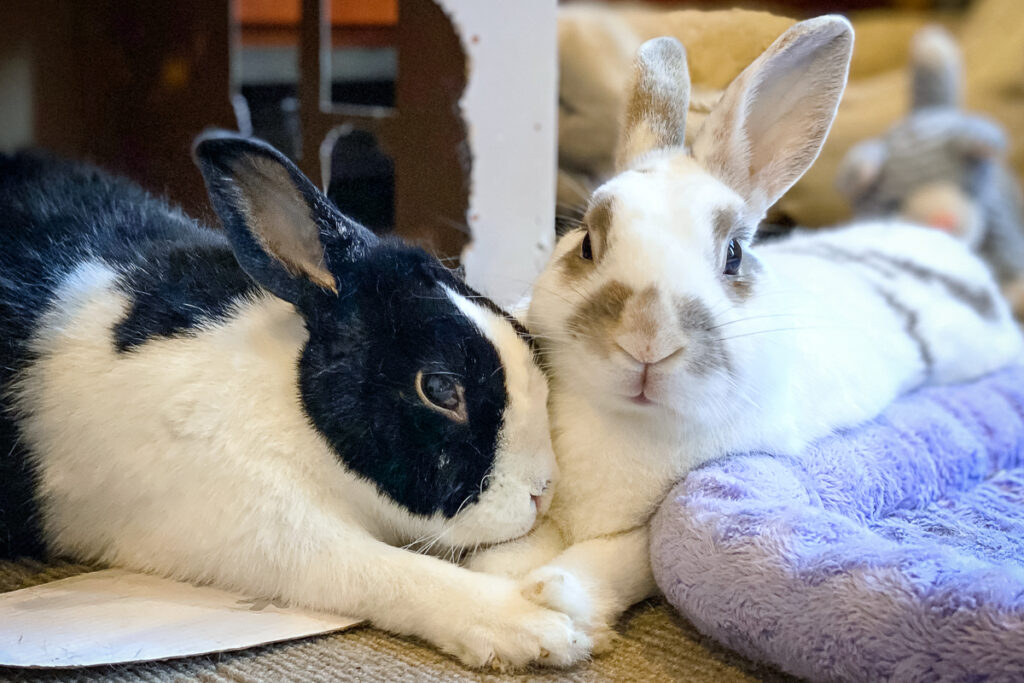OVER THE YEARS, HRS volunteers have found few generalizations that can safely be applied to all rabbits. The more rabbits we meet, the more exceptions we find. Only one truth remains unchallenged: Rabbits are not meant to live in solitude, away from members of their own kind. And yet, as House Rabbit Handbook author, Marinell Harriman, writes, “Although they are naturally sociable, rabbits don’t always know this important fact about themselves.” Introductions can be a thorny business, stressful for all involved. Thus previous articles have focused more on the how-to than the why.
LET ME COUNT THE WHYS
- The need for companionship is so deeply ingrained in rabbits that centuries of domestication have had little impact. Like humans and many other creatures, European wild rabbits (ancestors to domestic rabbits) need to live in groups. A community or warren consists of as many as a hundred individuals working together to create, maintain, and peacefully share a network of tunnels. Their lives include daily cooperation to find food, watch for and warn of predators, and protect, raise, and teach their young.
- The need for companionship can be met partially by a human, but once you live with a bonded pair or trio you will see that even the most devoted human cannot quite fill the bill. Bonded pairs are rarely out of each other’s sight. Humans will never be completely fluent in Rabbit. Rabbits talk to each other constantly, not so much with sounds as with movements. There are large movements such as dancing and grooming, and there are quite small communications of breath and slight shifts in position. You can sense some of this quiet conversation by lying on the floor beside two talkative rabbits. The bond between human and rabbit also can be deep and joyful. In fact, the closer we become to our rabbits, the more clearly do we understand their need for a friend of their own kind.
- Fortunately for all of us, what’s good for the bunny is very good for her human. HRS Colorado Chapter Manager Nancy LaRoche writes, “Pairs are much easier to care for, get into far less trouble, are happier, and tend to relate better to people. Boredom leads to bunny-in-trouble, and pairs don’t get nearly as bored because they are so busy relating to each other. Many adopters have told me, ‘If anyone doubts that pairs get into less trouble and relate better to people, tell them to call me! If I had known how much easier two rabbits would be, I’d never have gotten just one.’”
Boredom and depression are common symptoms of loneliness in rabbits. These are accompanied by destructiveness and hyperactivity in some rabbits (generally the smaller breeds), withdrawal in others. (Note: Call your veterinarian if your rabbit shows any sudden changes in behavior, as these may also be signs of physical illness.) - By adopting your new friend from a shelter or rescue group you can save two lives, which feels even better than saving one.
EXCEPTIONS TO THE RULE
Okay, so I lied. Even this almost constant, almost universal truth about rabbits does not apply to every single rabbit under the moon. How can you determine whether your bun is one of these rarities? You must ask other rabbits to tell you. Read the how-to series of articles (see sidebar), and set up introductions. If you find that Thumper really does not share your interest in living with rabbits, please consider a non-rabbit non-human friend for him. This is especially important for rabbits who are home alone much of the time. The solitude of an empty apartment would be unnatural even for the wild animals whom we label as solitary. As she goes about her daily business, a wild animal is surrounded by other living creatures. How much greater is the need for company among the social animals. Don’t let a busy schedule give you the guilts about quality time your rabbit is missing. Think guinea pigs (see sidebar). Think cats. Some bunnies coexist contentedly with a feathered friend. Cross-species introductions, in which territorial issues are muted, run a swifter and easier course than rabbit/rabbit situations. There may be somewhere a rabbit who is truly deeply solitary, but I have not met one in ten years of living with rabbits.
There are some medical reasons for not adopting a second rabbit. Rabbits of opposite sexes who are not spayed/neutered should never be with one another. In addition to being good preventive health care, this surgery allows for smooth introductions and loving long-term relationships between same-sex partners as well as male/female pairs. We have discussed spay/neuter in many previous articles and consider it a cornerstone of medical and behavioral health for all rabbits. Rabbits who are not spay/neutered will produce more rabbits, adding to the overpopulation problem. An unneutered rabbit who is too elderly for surgery, or a neutered individual who is frail or sick may not be able to handle the stress of an introduction to another rabbit, but may be a good candidate for a guinea pig friend.
Two rabbits are generally not more expensive than one. Pellets, hay, fresh fruits and vegetables, and litter–shopping for two puts little additional strain on the budget. The exception is medical care. Both must be spayed/neutered, and even if you start with a spayed/neutered pair, one or both rabbits may become ill and require veterinary care.
MENAGE A JOIE
Having introduced other companion animals to members of their own species (dogs, cats, guinea pigs), I’ve often wondered why rabbits require such particular strategizing and supervising. Could it be because their capacity for emotional relationships is so intense? The introduction can be as dramatically hostile as the marriage is devoted. Wild rabbits are very territorial, and this tendency may be intensified in the house rabbit’s environment. Living in a human home with few other creatures of any species, and possessed of a territorial instinct that has few outlets, for Thumper the arrival of a second rabbit becomes the focal point for powerful responses.
Introductions are often difficult for the supervising human. I have attended many introductions over the years, and only the first-hand observation of the happy, peaceful outcome of these skirmishes has reduced the stress level for me. If you’re not fortunate enough to be an HRS fosterer, the next best thing is the video “Introducing Rabbits” (see sidebar). This shows in detail the process by which rabbits who start out as implacable enemies are transformed into inseparable friends.
As we have seen over and over, once they make it through the introductory phase, the bonded pair become devoted to each other–so much so that care must be taken when one rabbit dies, leaving a grieving survivor. Bereaved rabbits often accept a new friend more readily than a rabbit who has never had a partner, a tribute to both the resilience and the sociality of rabbits. However, you may wish to spare your rabbit the heartache, and the illness that sometimes accompanies it, by introducing a third rabbit to your pair.
This is the main reason for having a threesome, but there are other benefits for you and for the rabbits. As with pairs, the only real increase in expense is medical care. The pleasure of observing and participating in interactions among rabbits increases exponentially with the number of animals present.
WILL SHE STILL LOVE ME?
This question often comes up when people are considering a second rabbit. Will my rabbit give all his affection to his new friend and have none to spare for his human? Remember that large warrens of rabbits live peacefully in close quarters.
There are special bonds among individuals, but no one is excluded. We can also look to our own hearts for the answer. Will you love your resident rabbit less when you have two–or more–with whom to share your days?
TWICE AS HAPPY
Save two lives instead of only one and your care may also turn out to be twice as easy.
©Copyright Amy Espie. All Rights Reserved. Republished with the permission of the author.
The Case for Rabbits in the Plural was originally published in House Rabbit Journal Volume III, Number 8, Summer 1996

